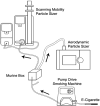Acute and chronic in vivo effects of exposure to nicotine and propylene glycol from an E-cigarette on mucociliary clearance in a murine model
- PMID: 28651446
- PMCID: PMC5553614
- DOI: 10.1080/08958378.2017.1336585
Acute and chronic in vivo effects of exposure to nicotine and propylene glycol from an E-cigarette on mucociliary clearance in a murine model
Abstract
Objective: To determine the effect of an acute (1 week) and chronic (3 weeks) exposure to E-cigarette (E-cig) emissions on mucociliary clearance (MCC) in murine lungs.
Methods: C57BL/6 male mice (age 10.5 ± 2.4 weeks) were exposed for 20 min/day to E-cigarette aerosol generated by a Joyetech 510-T® E-cig containing either 0% nicotine (N)/propylene glycol (PG) for 1 week (n = 6), or 3 weeks (n = 9), or 2.4% N/PG for one week (n = 6), or 3 weeks (n = 9), followed by measurement of MCC. Control mice (n = 15) were not exposed to PG alone, or N/PG. MCC was assessed by gamma camera following aspiration of 99mtechnetium aerosol and was expressed as the amount of radioactivity removed from both lungs over 6 hours (MCC6hrs). Venous blood was assayed for cotinine levels in control mice and in mice exposed for 3-weeks to PG alone and N/PG.
Results: MCC6hrs in control mice and in mice acutely exposed to PG alone and N/PG was similar, averaging (±1 standard deviation) 8.6 ± 5.2%, 7.5 ± 2.8% and 11.2 ± 5.9%, respectively. In contrast, chronic exposure to PG alone stimulated MCC6hrs (17.2 ± 8.0)% and this stimulation was significantly blunted following chronic exposure to N/PG (8.7 ± 4.6)% (p < .05). Serum cotinine levels were <0.5 ng/ml in control mice and in mice exposed to PG alone, whereas, N/PG exposed mice averaged 14.6 ± 12.0 ng/ml.
Conclusions: In this murine model, a chronic, daily, 20 min-exposure to N/PG, but not an acute exposure, slowed MCC, compared to exposure to PG alone and led to systemic absorption of nicotine.
Keywords: E-cigarette emissions; acute exposure; chronic exposure; mucociliary clearance; murine model.
Conflict of interest statement
No financial interest, or benefit, has arisen from this research.
Figures








Similar articles
-
Electronic-Cigarette Vehicles and Flavoring Affect Lung Function and Immune Responses in a Murine Model.Int J Mol Sci. 2020 Aug 21;21(17):6022. doi: 10.3390/ijms21176022. Int J Mol Sci. 2020. PMID: 32825651 Free PMC article.
-
The effects of electronic cigarette emissions on systemic cotinine levels, weight and postnatal lung growth in neonatal mice.PLoS One. 2015 Feb 23;10(2):e0118344. doi: 10.1371/journal.pone.0118344. eCollection 2015. PLoS One. 2015. PMID: 25706869 Free PMC article.
-
Electronic cigarette solvents, pulmonary irritation, and endothelial dysfunction: role of acetaldehyde and formaldehyde.Am J Physiol Heart Circ Physiol. 2021 Apr 1;320(4):H1510-H1525. doi: 10.1152/ajpheart.00878.2020. Epub 2021 Feb 5. Am J Physiol Heart Circ Physiol. 2021. PMID: 33543686 Free PMC article.
-
Nicotine and Cotinine Levels With Electronic Cigarette: A Review.Int J Toxicol. 2016 Mar-Apr;35(2):179-85. doi: 10.1177/1091581815618935. Epub 2015 Dec 16. Int J Toxicol. 2016. PMID: 26681385 Review.
-
Nicotine intoxication by e-cigarette liquids: a study of case reports and pathophysiology.Clin Toxicol (Phila). 2020 Jan;58(1):1-8. doi: 10.1080/15563650.2019.1636994. Epub 2019 Jul 9. Clin Toxicol (Phila). 2020. PMID: 31286797 Review.
Cited by
-
The Effects of Electronic Cigarette (ECIG)-Generated Aerosol and Conventional Cigarette Smoke on the Mucociliary Transport Velocity (MTV) Using the Bullfrog (R. catesbiana) Palate Paradigm.Front Physiol. 2017 Dec 11;8:1023. doi: 10.3389/fphys.2017.01023. eCollection 2017. Front Physiol. 2017. PMID: 29321743 Free PMC article.
-
Changes in Multiple and Different Tobacco Product Use Behaviors in Women Before and During Pregnancy: An Analysis of Longitudinal Population Assessment of Tobacco and Health Data.Am J Prev Med. 2020 Oct;59(4):588-592. doi: 10.1016/j.amepre.2020.05.006. Epub 2020 Aug 20. Am J Prev Med. 2020. PMID: 32828586 Free PMC article.
-
Nicotine aerosols diminish airway CFTR function and mucociliary clearance.Am J Physiol Lung Cell Mol Physiol. 2023 May 1;324(5):L557-L570. doi: 10.1152/ajplung.00453.2021. Epub 2023 Feb 28. Am J Physiol Lung Cell Mol Physiol. 2023. PMID: 36852921 Free PMC article.
-
Effect of sub-chronic exposure to cigarette smoke, electronic cigarette and waterpipe on human lung epithelial barrier function.BMC Pulm Med. 2020 Aug 12;20(1):216. doi: 10.1186/s12890-020-01255-y. BMC Pulm Med. 2020. PMID: 32787821 Free PMC article.
-
The paradox of the safer cigarette: understanding the pulmonary effects of electronic cigarettes.Eur Respir J. 2024 Jun 28;63(6):2301494. doi: 10.1183/13993003.01494-2023. Print 2024 Jun. Eur Respir J. 2024. PMID: 38609098 Free PMC article. Review.
References
-
- Armendariz AJ, Leith D. Concentration measurement and counting efficiency for the aerodynamic particle sizer 3320. J Aerosol Sci. 2002;33:133–48.
-
- Armitage AK, Dixon M, Frost BE, et al. The effect of tobacco blend additives on the retention of nicotine and solanesol in the human respiratory tract and on subsequent plasma nicotine concentrations during cigarette smoking. Chem Res Toxicol. 2004;17:537–44. - PubMed
Publication types
MeSH terms
Substances
Grants and funding
LinkOut - more resources
Full Text Sources
Other Literature Sources
Medical
